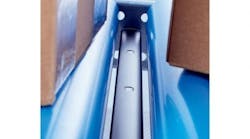QC Industries has added another component to their popular line of Automation Series Conveyors: AS40Z Angled Frame Conveyors. They enable elevation changes that aren’t possible with a flat conveyor. AS40Z Conveyors feature the same 1.95”-high rigid aluminum frame offered in other Automation Series Conveyors. Its design resists twisting, which is a leading cause of belt tracking issues in competing conveyors. They also feature QC Industries’ unique Z-Track design to help make tracking simple. Optional V-Guide belts can assist in tracking, especially in hard-to-reach applications. Like other Automation Series Conveyors, AS40Z conveyors include Tension Release Tails, which flip up at the push of a button to allow easy under-belt cleaning. They then click back into place with all tracking adjustments retained. The reduced torque requirements for QC Industries’ Automation Series Conveyors allow the use of smaller motors than other angled frame conveyors, letting them fit into spaces other conveyors cannot. One such motor is the brushless DC motor that affords high-tech control in a small package.
AS40Z Conveyors are available in three configurations for any elevating or lowering application. The L is a horizontal to inclined configuration and the R is inclined to horizontal, while the Z is horizontal to inclined to horizontal. The three most popular angles — 30°, 45° and 60° — are available as standard, while others are available as special orders.
A wide variety of belt options are available, including those with cleats and corrugated sidewalls that help keep product contained on the belt. They can carry loads up to 120 lbs. and move at speeds up to 200 FPM. Widths are available from 8”–24” and lengths up to 20’.
QC Industries’ Automation Series low profile belt conveyors are used in a wide variety of applications including packaging, automation, assembly, medical product and device manufacturing, material handling, manufacturing, and more.
- enable elevation changes
- 1.95”-high rigid aluminum frame
- allow the use of smaller motors





